Faculty Development Programme on Implementation of Sponsored Projects
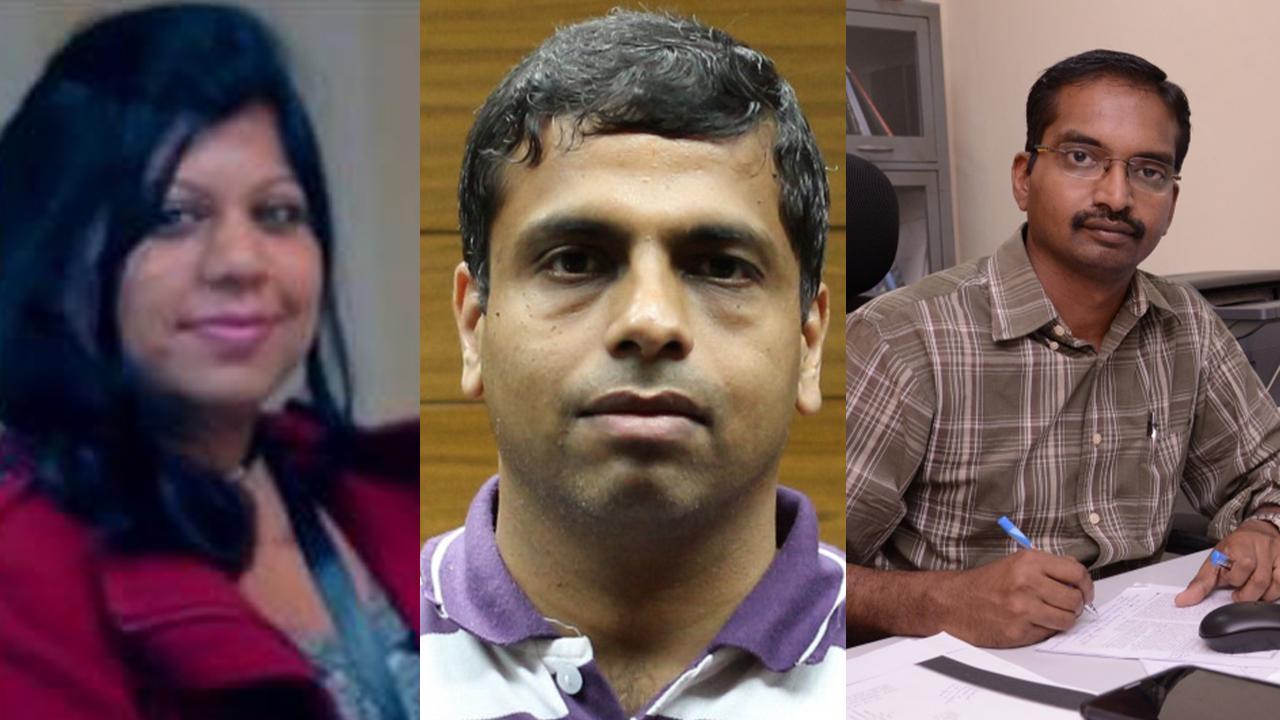
The Department of Physics organised a Faculty Development Programme discussing the scopes of implementing sponsored projects. Renowned academicians, Prof Sathish Vadhiyar, IISc Bangalore; Prof Kothandaraman Ramanujam, IIT Madras; and Prof Paromita Chakraborty, SRMIST were the keynote speakers of the session. They shared their views and enlightened the faculty on the scopes and challenges in implementing projects proposed across various disciplines.
Prof V S Rao, Vice-Chancellor SRM-AP, welcomed the gathering. He appreciated the department’s effort in organising programmes on such impactful topics. Reminding the community of the inevitability of emphasising research, he congratulated all the faculty for their influential publications, sponsored projects, patent publications, etc. Prof D Narayana Rao, Pro-Vice-Chancellor, also addressed the gathering and reiterated the need to conduct such crucial discussions among administrators and policymakers. He further highlighted the importance of reorienting the vision of every Indian university by giving a special focus on research and development.
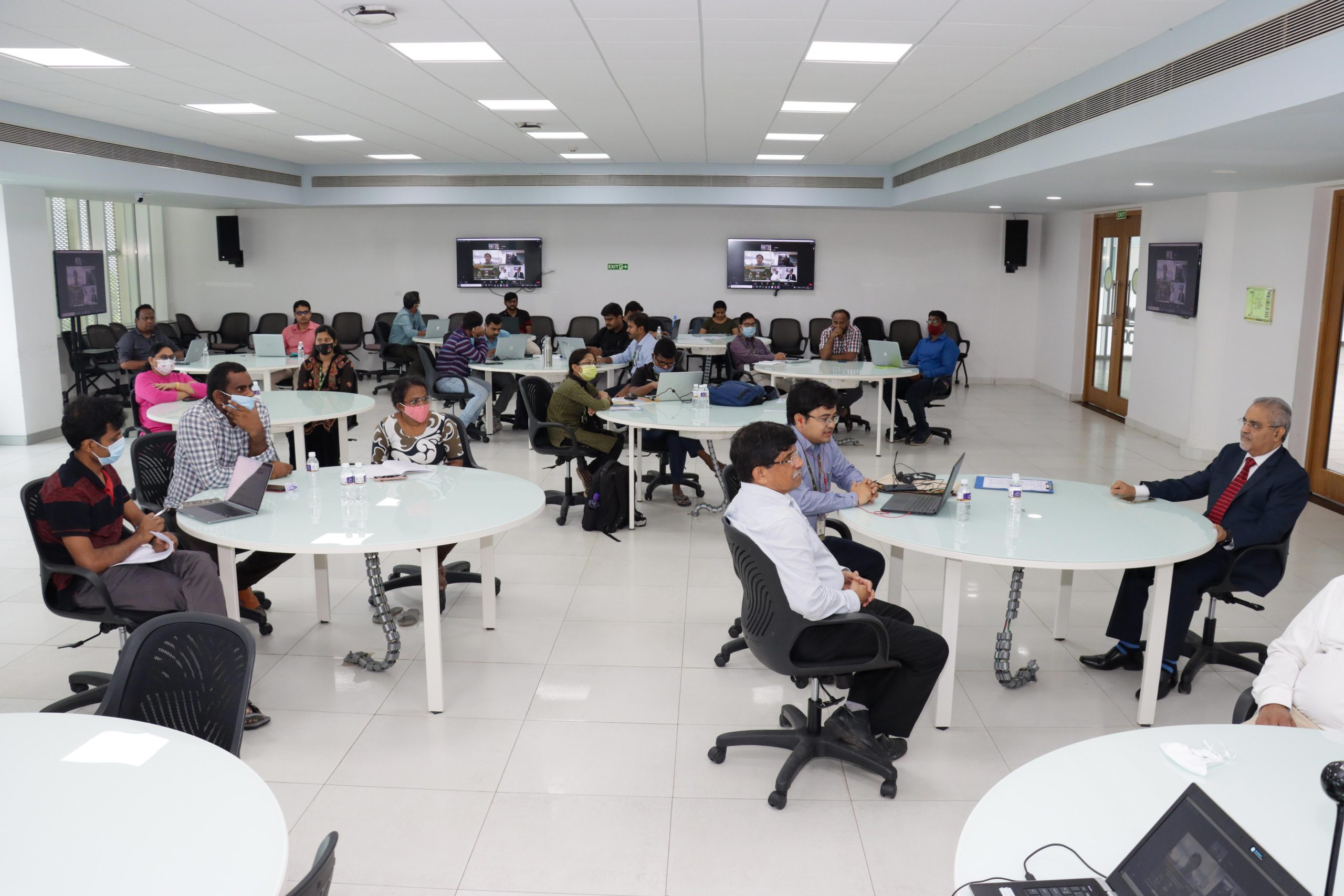
Prof Sathish Vadhiyar commenced the discussion by providing a brief overview of the National Super Computing Mission (NSM). It is one of the principal ventures funded by DST and MeItY to advance the overall high-performance computing ecosystem. He deliberated on the R&D projects involved in NSM, its objectives, proposal areas, budget, research allocations etc. Prof Ramanujam presided over and shared his experience in collaborating with industries to market the research product. He gave a detailed analysis of the functioning of consultation companies, types of consultancies, stages involved in such projects, and the different ways to attract funding. Prof Paromita Chakraborty was the last speaker of the day. She offered an elaborate outline for designing and developing a project proposal and concluded by imparting a few insights from her successful projects.
- Published in Departmental News, News, Physics News
PAN/PVP blend nanofiber air filtration mechanism
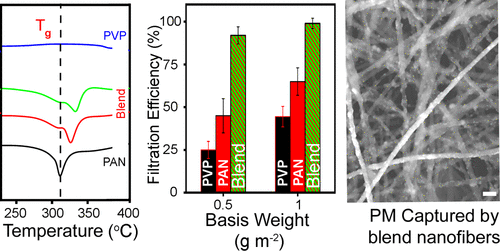
Studies and research on air pollution have sparked worldwide interest in the recent decades to overcome the imminent threat of air pollution. The air filtration mechanism is one of the efficient ways to capture particulate matter (PM) and purify the air. An innovatory air filtration mechanism blending polyacrylonitrile (PAN)/polyvinylpyrrolidone (PVP) polymer nanofibers has been proposed by Prof Ranjit Thapa and his PhD scholar Deepak S Gavali from the Department of Physics.
The paper “Low Basis Weight Polyacrylonitrile/Polyvinylpyrrolidone Blended Nanofiber Membranes for Efficient Particulate Matter Capture” was published in collaboration with Applied NanoPhysics Laboratory, Department of Physics and Nanotechnology, SRM Institute of Science and Technology, Kattankulathur. It was featured in the journal ‘ACS Applied Polymer Materials’ having an Impact Factor of 4.09.
In the twenty-first century, air pollution is a major problem facing human and environmental health. Every year, millions of people die, mostly in developing nations, owing to the aggravating level of air pollution. According to the World Health Organization (WHO), 92 per cent of the people live in places where the air quality level has crossed the WHO limits. Particulate matter (PM) (solid or liquid particles with different aerodynamic diameters), nitrogen dioxide (NO2), ozone (O3), and others are the relevant air contaminants.
In low-income cities, the effect of PM 2.5 pollution is high due to high urban air pollution. Even at very low concentrations, PM 2.5 (particles with an aerodynamic diameter less than 2.5 µm) pollution has health consequences. Air filtration is one of the best remedies to tackle such problems and maintain a clean environment for humans. Among the available air filter materials, fiber-based air filters have proven to be the most potentially effective treatment, due to their high porosity, high surface area, lightweight, etc.
This study relies on a careful design that blends PAN and PVP fibers. The resultant nanofiber material is utilized to overcome the low air pressure resistance issue with high filtration efficiency. Large-scale free-standing nanofibers were obtained by a simple peeling-off process. The morphology, chemical interaction between the filter media and PM pollutant; and filtration properties were investigated. Compared to commercial mask, the semi- high-efficiency particulate air (HEPA) filter media, PAN/PVP filter medium showed superior performance in PM 2.5 filtration. Furthermore, the intermolecular interactions between PMs and nanofibers were analyzed by DFT calculations. With constant optimization of synthesis conditions, the synthesized air filters achieved high filtration efficiency for PM removal and showed great potential for practical application.
Abstract of the Research
Particulate matter (PM) in air frequently poses a serious threat to human health. Smaller PM can easily enter into the alveolus and blood vessels with airflow. This work reports the first polyacrylonitrile (PAN)/polyvinylpyrrolidone (PVP) polymer blend nanofiber filter media for effectively capturing PM. Density functional theory (DFT) calculations are used to investigate the effect of the blending of two polymers on the dipole moment and the electrostatic potential. Based on the DFT calculations of the intermolecular interactions between nanofibers and PM, the PAN/PVP heteromolecular percentage is considered for experimental synthesis, which can provide better performance in the filtration of pollutants. The composite PAN/PVP fiber network was successfully developed and optimized to cope with complex environments during the actual filtration process. The role of the blending ratio of PAN and PVP in wt % was explored on PM 2.5 capture, and the refined ratio overcame the conflict between high filtration efficiency and low air pressure resistance. The air filter medium PAN/PVP (6:2) possesses an extremely high air filtration efficiency of 92% under a very low pressure drop of 18 Pa for a 0.5 g m–2 basis weight. Both polar and nonpolar functional groups in blend nanofibers promoted significantly the electrostatic attraction and improved the filtration efficiency under static and dynamic airflow. The PAN/PVP nanofiber membranes maintain outstanding air filtration under different temperature and humidity conditions. This study will shed light on the fabrication of high-efficiency low-basis weight nanofiber filter media as an end product.
- Published in Departmental News, News, Physics News, Research News
Co-edited and authored in the world’s longest-running science journal
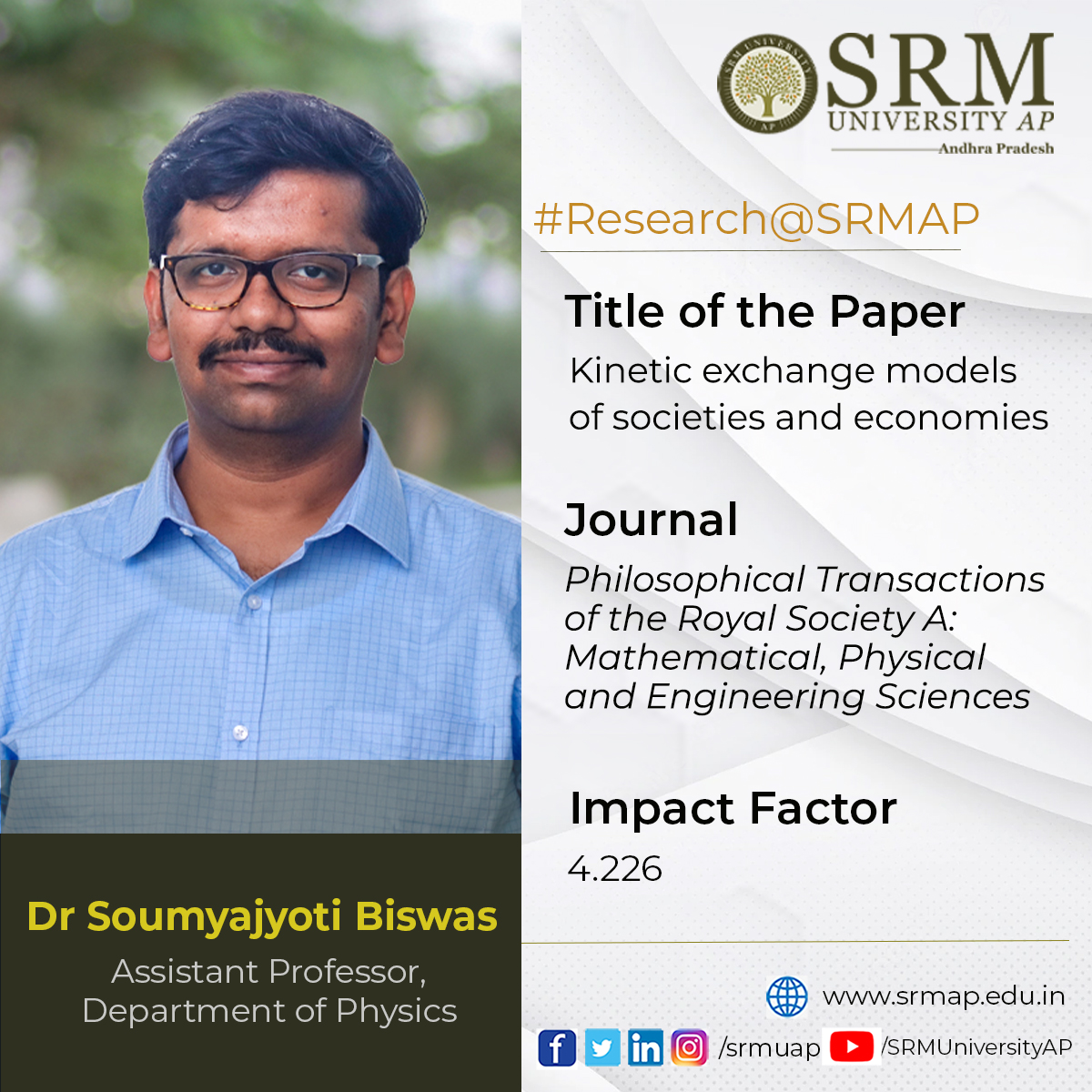
Dr Soumyajyoti Biswas, Assistant Professor, Department of Physics, had two lucky breaks as he got his article “Kinetic Exchange Models of Societies and Economies” featured in the prestigious journal Philosophical Transactions of the Royal Society A, the theme issue co-edited by Dr Biswas himself, along with Dr Guiseppe Toscani from the University of Pavia, and Dr Parongama Sen from the University of Calcutta. Philosophical Transactions of the Royal Society has the prestige of being the world’s longest-running science journal launched in 1665. Publishing high-quality theme issues on topics of current importance and general interest within the physical, mathematical, and engineering sciences, the journal continues its history of influential scientific publishing.
A kinetic model of binary interaction, with conserving or non-conserving exchange, has been an elegant and powerful tool to explain collective phenomena in myriad human interaction-based problems, where an energy consideration for dynamics is generally inaccessible. Nonetheless, in this age of Big Data, seeking empirical regularities emerging out of collective responses is a prominent and essential approach, much like the empirical thermodynamic principles preceding quantitative foundations of statistical mechanics.
Through this theme issue, the authors intend to bring together the current progress in the applications of kinetic exchange models in various applications of societies (opinion formations, rating, social networks, fake news, etc.) and economies (inequality measures, taxation, trade models, behavioral economics, etc.) using numerical simulations, machine learning techniques, analytical methods, and data analysis, reported by physicists, social scientists, mathematicians and economists through some of the original and reviewed articles.
In human interactions, such as a trade (exchange of money) or, discussions or debates (exchange of opinions), following simple dynamical rules, a collection of agents (a society) shows emergent properties that are widely seen in real data (distributions of wealth, formation of consensus, etc.). Without knowing the complexities that are involved at the individual levels, it is, therefore, possible to understand the average properties of the society as a whole. This is reminiscent of simple elastic collisions of ideal gas molecules that give average thermodynamic properties, such as temperature, pressure, etc. without knowing the complexities of the individual atoms. This has been a widely followed route to formulate statistical physical models of societies and economies.
The kinetic exchange models have been a very successful set of tools to understand the socio-economic emergent properties from simple models. Among other things, these models helped understand the growth of economic inequalities, the effects of taxes as well as the spread of opinions. A close quantitative resemblance with real data from various countries of the world demonstrates its usefulness.
The future prospects of the kinetic exchange models for societies and economies include possible predictions of extreme fluctuations in average measurable quantities by looking at the inequality of time series data. The models can help us in identifying the features of the real data that can mirror the underlying extreme fluctuations.
- Published in Departmental News, News, Physics News, Research News
Interdisciplinary research and the integration of perspectives
Assistant professors Dr Sabyasachi Mukhopadhyay and Dr Imran Pancha from the Department of Physics and the Department of Biological Sciences, respectively, along with Ms Ashwini Nawade, a PhD student of the Department of Physics, have developed a method to integrate plant proteins in the solid-state electronic circuits and utilize the biological functionality to produce a thin film, cost-effective photodetector. Their paper entitled Electron Transport across Phycobiliproteins Films and its’ Optoelectronic Properties has been published in the ECS Journal of Solid State Science and Technology with an Impact Factor of 2.07. It is an interdisciplinary research project between the Department of Biotechnology and Physics.
Explanation of the research
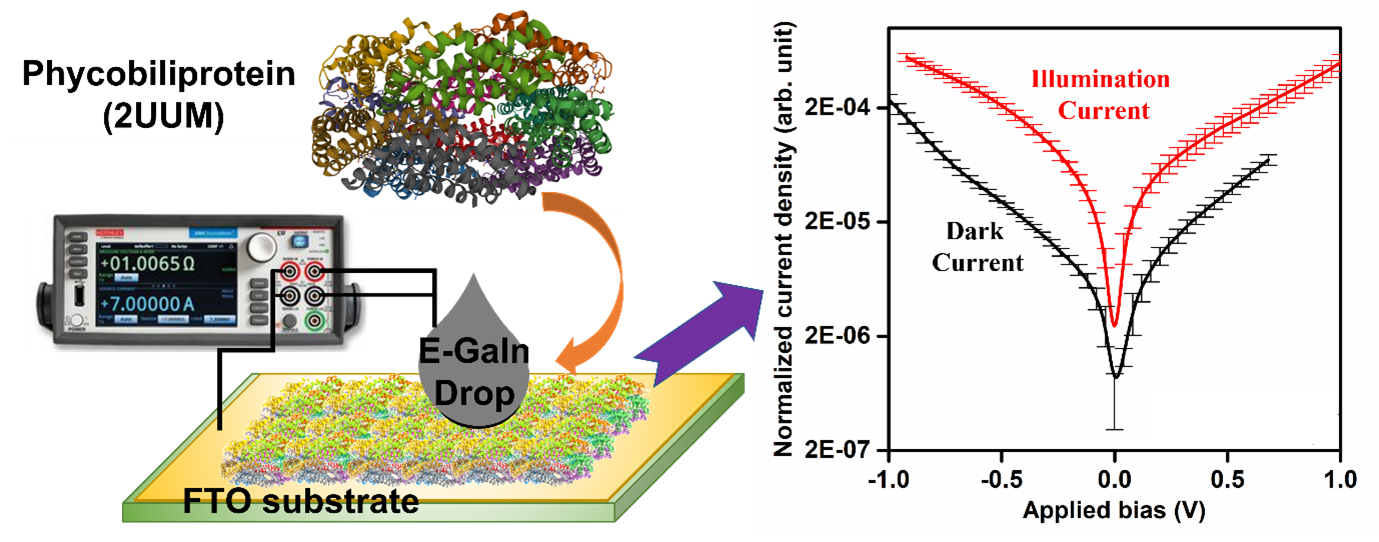 Biomolecules such as proteins, peptides being the most crucial life-forms, have an intimate relationship with various life activities for biological functions. The contemporary work with biomolecules mainly focuses on its evolving potential associated with nanoscale electronics where proteins and peptides are integrated as sensing materials. The researchers explored the optoelectronics functionality of combined proteins known as phycobiliproteins. They investigated electron transport behavior across the phycobiliproteins films under dark and white light illumination. The research affirms that the photochemical activity of the protein is more stable in a solid-state/ thin-film with tightly bonded water molecules than its presence in a buffer solution. Furthermore, the studies demonstrate that phycobiliproteins films modulate their electrical conductivity within their different conformation states. Researchers speculate that the electrical conductance variation could originate from the chemical alteration of cysteine-conjugated bilin chromophores to protein and the electrostatic environment around the chromophores.
Biomolecules such as proteins, peptides being the most crucial life-forms, have an intimate relationship with various life activities for biological functions. The contemporary work with biomolecules mainly focuses on its evolving potential associated with nanoscale electronics where proteins and peptides are integrated as sensing materials. The researchers explored the optoelectronics functionality of combined proteins known as phycobiliproteins. They investigated electron transport behavior across the phycobiliproteins films under dark and white light illumination. The research affirms that the photochemical activity of the protein is more stable in a solid-state/ thin-film with tightly bonded water molecules than its presence in a buffer solution. Furthermore, the studies demonstrate that phycobiliproteins films modulate their electrical conductivity within their different conformation states. Researchers speculate that the electrical conductance variation could originate from the chemical alteration of cysteine-conjugated bilin chromophores to protein and the electrostatic environment around the chromophores.
The research explores the photochemical properties and electrical transport efficiency of phycobiliproteins (PBPs) films. In addition, it investigates the optoelectronics functionality of PBPs films by studying electron transport behavior across the protein films under a dark state and white light illumination. The researchers proposed to develop a photodetector with the protein film in the future.
- Published in Biology News, Departmental News, News, Physics News, Research News
Reconceiving the building blocks of the Universe
The research at the Department of Physics is currently focusing on developing new theoretical frameworks to revamp the fundamental concepts that describe the origin of the universe. Assistant Professor Dr Amit Chakraborty has published a paper titled Revisiting Jet Clustering Algorithms for New Higgs Boson Searches in the Hadronic Final States in the European Physical Journal C, with an Impact Factor of 4.59.
Abstract
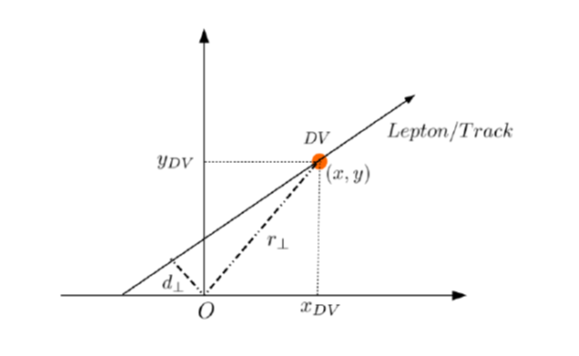 Displaced signatures originating from the pair production of a supersymmetric particle, called sneutrino, at the Large Hadron Collider (LHC) are studied. The theoretical model considered in this work is the Next-to-Minimal Supersymmetric Standard Model supplemented with right-handed neutrinos triggering a Type-I seesaw mechanism. The research has shown how such signatures can be established through a heavy Higgs portal when the sneutrinos are decaying to charged leptons and charginos giving rise to further leptons or hadrons. The research also illustrated how the Yukawa parameters of neutrinos can be extracted by measuring the lifetime of the sneutrino from the displaced vertices, thereby characterising the dynamics of the underlying mechanism of neutrino mass generation.
Displaced signatures originating from the pair production of a supersymmetric particle, called sneutrino, at the Large Hadron Collider (LHC) are studied. The theoretical model considered in this work is the Next-to-Minimal Supersymmetric Standard Model supplemented with right-handed neutrinos triggering a Type-I seesaw mechanism. The research has shown how such signatures can be established through a heavy Higgs portal when the sneutrinos are decaying to charged leptons and charginos giving rise to further leptons or hadrons. The research also illustrated how the Yukawa parameters of neutrinos can be extracted by measuring the lifetime of the sneutrino from the displaced vertices, thereby characterising the dynamics of the underlying mechanism of neutrino mass generation.
Explanation of the research
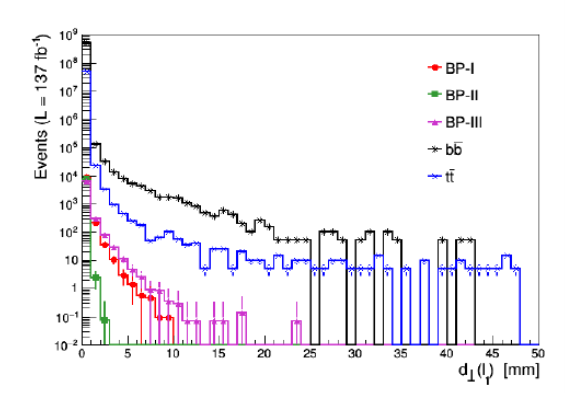 The Standard Model of Particle Physics is currently the remarkably successful theory to describe the basic building blocks of the universe and their interactions with the three fundamental forces of nature. Despite its success at explaining the universe, the Standard Model does have several limitations. For example, how neutrinos get their mass, why the mass spectrum of the different elements of SM fermions, namely quarks and leptons, are so hierarchical, why the Higgs boson mass is so low, etc. The primary research is to understand these issues and then propose theoretical models which circumvent these shortcomings of SM and provide signatures that can be tested in the ongoing or future proposed experiments.
The Standard Model of Particle Physics is currently the remarkably successful theory to describe the basic building blocks of the universe and their interactions with the three fundamental forces of nature. Despite its success at explaining the universe, the Standard Model does have several limitations. For example, how neutrinos get their mass, why the mass spectrum of the different elements of SM fermions, namely quarks and leptons, are so hierarchical, why the Higgs boson mass is so low, etc. The primary research is to understand these issues and then propose theoretical models which circumvent these shortcomings of SM and provide signatures that can be tested in the ongoing or future proposed experiments.
For this research project, Dr Amit Chakraborty have collaborated with Particle Physics Department, STFC Rutherford Appleton Laboratory, UK and School of Physics and Astronomy, University of Southampton, UK. His broad research interest is to perform theoretical studies of physics beyond the Standard Model (BSM) in particular, collider search strategies and prospects of different BSM models at the Large Hadron Collider (LHC) and future proposed collider experiments. He aims to build new theoretical models, develop new techniques/tools, and devise new search strategies to improve our knowledge of the standard model as well as BSM physics processes.
Dr Amit Chakraborty’s future research topics include Higgs Boson Physics and Beyond Standard Model Physics Phenomenology, Dark Matter at the Colliders, Interpretable Machine Learning techniques in BSM Physics, and Ultra-light particles and Physics Beyond the Colliders.
- Published in Departmental News, News, Physics News, Research News
Applying the Pareto principle in disordered systems
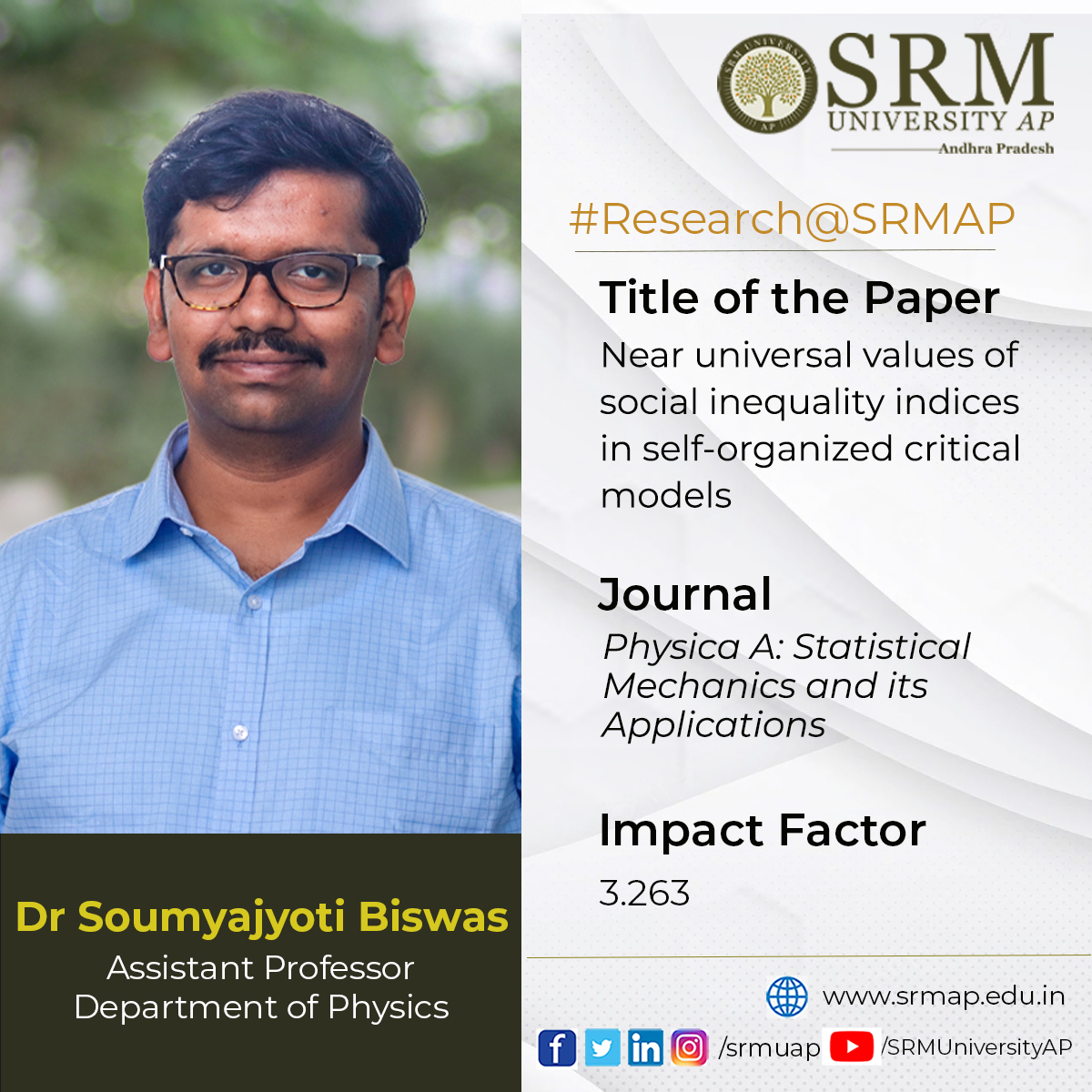
The Department of Physics is glad to announce that Dr Soumyajyoti Biswas, Assistant Professor, has published a paper titled ” Near universal values of social inequality indices in self-organized critical models” in the journal Physica A: Statistical Mechanics and its Applications having an impact factor of 3.263. This research was done in collaboration with Prof S S Manna of S N Bose National Center for Basic Sciences and Prof B K Chakrabarti of Saha Institute of Nuclear Physics.
It is well known that wealth invariably accumulates only in a few hands while a majority of the world continues to remain poor. In economics, it is quantified in Pareto’s 80-20 law (20% of people possess 80% of wealth) or ‘The Law of the Vital Few’. This research reveals that the implication of this law goes far beyond the socio-economic systems. It is also a crucial indicator of the onset of critical phenomena in a wide class of physical systems.
It has been observed that in the dynamics of disordered systems, such as fracture and breakdown of solids, slowly increasing the external force produces acoustic emissions (crackling noise), the sizes of which follow Pareto-like behaviour (most noises are weak, only a few are strong that results in the breakdown). Quantifications of these “inequalities” in these physical systems reveal some universal characteristics in a wide class of models, known as self-organized critical systems.
The main implication of this observation lies in predicting catastrophic breakdown in disordered systems. Applications of these inequality measures, which are traditionally in the domain of social sciences, have proved to be immensely useful in identifying the approaching breakdown points in the models of disordered systems. Given that the methods are applicable to a wide variety of models, the 80-20 law has the potential for a wide range of applications. Dr Biswas and his PhD student Diksha are currently working with a team in Spain on experimental data and studying these inequalities in real systems.
- Published in Departmental News, News, Physics News, Research News
The potential applications of NdNiO3
Research at the Department of Physics is currently exploring the potential applications of NdNiO3. Recently, Professor Ranjit Thapa, and his Ph D student, Mr Deepak S Gavali published the paper, Low-Temperature Spin-Canted Magnetism and Bipolaron Freezing Electrical Transition in Potential Electron Field Emitter NdNiO3 in the journal ACS Applied Electronic Materials, with an Impact Factor of 3.314. This work is done in collaboration with the Department of Physics and Astronomy, National Institute of Technology Rourkela, Rourkela, Odisha, India.
About the research
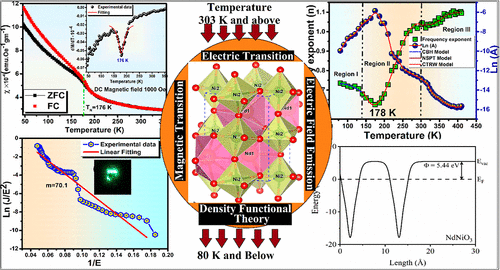 In this work, NdNiO3 nanoparticles are synthesized by sol-gel auto-combustion techniques, and its primary characterization related to structural and surface morphological analysis is carried out by X-Ray Diffraction (XRD), Fourier Transforms Infrared Spectroscopy (FTIR), Field Emission Scanning Electron Microscopy (FESEM), Energy-Dispersive X-ray spectroscopy (EDX), and Transmission Electron Microscopy (TEM) techniques. The research is focused on magnetic phase transition below Curie temperature (TN) ∼176 K, and the magnetic susceptibility indicates a weak antiferromagnetic ordering at low temperature. Different ac conduction mechanisms, that is, Correlated Barrier Hopping (CBH), Continuous-Time Random Walk (CTRW) conduction model, and Non-overlapping Small Polaron Tunneling (NSPT), are introduced to interpret its electrical transport behavior near, above, and below TMI ∼178 K. Using first principles and Density of States (DOS) calculation, the researchers have characterized the electronic and magnetic ground state of NdNiO3 at room temperature. It exposed the overlapping of conduction and valence band at room temperature, and the degree of hybridization between Ni 3d and O 2p is very high compared to Nd 5d states. The work function is also calculated for a few-layer NdNiO3 to estimate the field enhancement factor (β), which plays a crucial role in the practical application of a field emitter.
In this work, NdNiO3 nanoparticles are synthesized by sol-gel auto-combustion techniques, and its primary characterization related to structural and surface morphological analysis is carried out by X-Ray Diffraction (XRD), Fourier Transforms Infrared Spectroscopy (FTIR), Field Emission Scanning Electron Microscopy (FESEM), Energy-Dispersive X-ray spectroscopy (EDX), and Transmission Electron Microscopy (TEM) techniques. The research is focused on magnetic phase transition below Curie temperature (TN) ∼176 K, and the magnetic susceptibility indicates a weak antiferromagnetic ordering at low temperature. Different ac conduction mechanisms, that is, Correlated Barrier Hopping (CBH), Continuous-Time Random Walk (CTRW) conduction model, and Non-overlapping Small Polaron Tunneling (NSPT), are introduced to interpret its electrical transport behavior near, above, and below TMI ∼178 K. Using first principles and Density of States (DOS) calculation, the researchers have characterized the electronic and magnetic ground state of NdNiO3 at room temperature. It exposed the overlapping of conduction and valence band at room temperature, and the degree of hybridization between Ni 3d and O 2p is very high compared to Nd 5d states. The work function is also calculated for a few-layer NdNiO3 to estimate the field enhancement factor (β), which plays a crucial role in the practical application of a field emitter.
Practical implications
The additional novelty of the present work is to explore the potential application of NdNiO3 as an efficient field emitter and controlled electron/X-ray sources in a flat panel display, microwave vacuum electronic devices, electron microscopy/ lithography, and so forth. To eject conducting electrons from the metal/semiconducting surface by a quantum mechanical tunneling process, sufficient energy is required in terms of the applied electric field (∼106 to 107 V/cm) to overcome the potential barrier at the vacuum−metal interface. The potential difference between the Fermi level (Ef ) of the metal surface to vacuum is known as the work function (Φ). It depends on material characteristics and plays an essential role in field enhancement capability. The primary requirement for efficient field emitters is high aspect ratios (i.e., field enhancement factor), inferior turn-in field, low work, function, etc. Researchers have examined various classes of materials for efficient field emitter electrodes, such as (i) carbonaceous materials like graphene and carbon nanotube, (ii) various 1D and 2D metal oxide and transition metal dichalcogenides like ZnO, MnO2, In2O3, WS2, WSe2, MoS2, PdSe2, etc., (iii) inorganic semiconductors like SiC and Si, and (iv) wide band gap semiconducting compounds GaN, AIN, and so on. The field emission properties of rare earth nickelates (RNiO3; R = La, Gd, Nd, Sm, etc.) with an exciting room temperature metallic nature have not been examined.
- Published in Departmental News, News, Physics News, Research News
Neodymium-doped bismuth ferrite thin films for random access memory applications
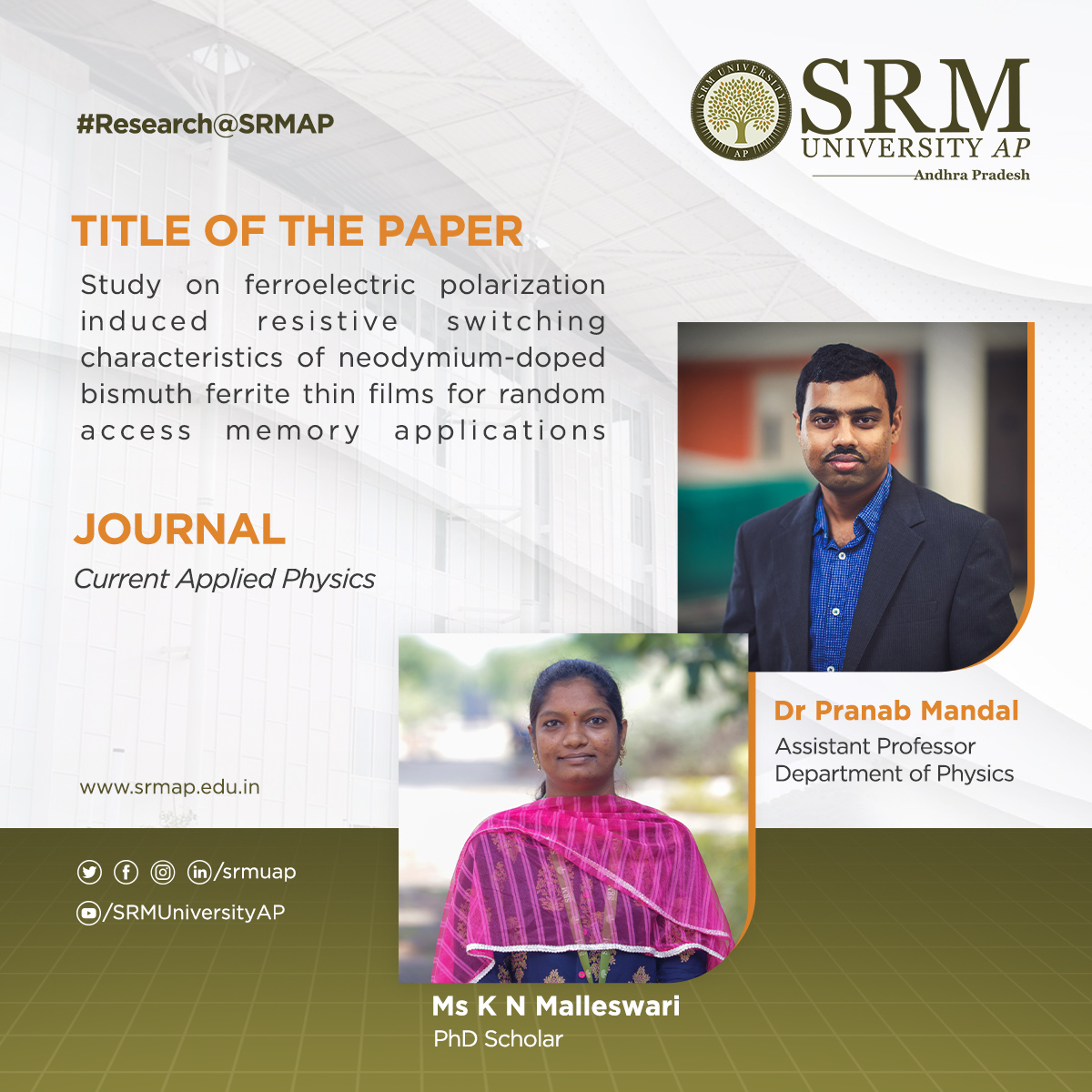 A paper titled “Study on ferroelectric polarization induced resistive switching characteristics of neodymium-doped bismuth ferrite thin films for random access memory applications” has been published by Dr Pranab Mandal, Assistant Professor of Physics and his PhD student, Ms K N Malleswari in the journal ‘Current Applied Physics’ having an Impact Factor of 2.480.
A paper titled “Study on ferroelectric polarization induced resistive switching characteristics of neodymium-doped bismuth ferrite thin films for random access memory applications” has been published by Dr Pranab Mandal, Assistant Professor of Physics and his PhD student, Ms K N Malleswari in the journal ‘Current Applied Physics’ having an Impact Factor of 2.480.
Doi: https://doi.org/10.1016/j.cap.2022.04.013
Abstract
Resistive random-access memory (ReRAM) devices are based on the resistance switching (RS) effect. Such RS devices have recently attracted significant attention due to their potential application in realizing the next-generation non-volatile memory (NVM) devices. The present work reports on resistive switching (RS) characteristics of Neodymium (Nd)-doped bismuth ferrite (BFO) layers. The Nd (2–10 at%) doped BFO thin film layers were deposited using a spray pyrolysis method. The structural analysis reveals that a higher Nd doping concentration in BFO leads to significant distortion of the prepared Nd: BFO thin films from rhombohedral to tetragonal characteristics. The morphological analysis shows that all the deposited Nd: BFO thin films have regularly arranged grains. The X-ray photoelectron spectroscopy (XPS) analysis reveals that the prepared Nd: BFO thin films have a higher Fe3+/Fe2+ ratio and fewer oxygen vacancy (VO) defects which enrich the ferroelectric characteristics in Nd: BFO layers. The polarization-electric field (P-E) and RS characteristics of the fabricated Nd: BFO-based RS device were examined. It was observed that the Nd (7 at%) doped BFO RS device shows large remnant polarization (P r) of 0.21 μC/cm2 and stable RS characteristics.
Research in brief
Non-volatile resistive random access memory (RRAM) are future generation random access memory device with potential benefits such as high operational speed (nanoseconds read and write time), non-volatility, high endurance scalability and low power consumption [Namnoscale Research Lett., 15, 90, 2020]. Here in this work, we presented the resistive switching characteristics of a multiferroic material namely Nd-doped BiFeO3 material. The device shows stable resistive switching characteristics.
Practical implementation/social implications
Researchers in this field are focusing to overcome challenges of high operation current, lower resistance ratios, and reliability issues [Namnoscale Research Lett., 15, 90, 2020]. While several prototype RRAMs have been developed by other groups, future memory applications would require overcoming the challenges mentioned above.
Collaboration
The work has been conceptualized by Dr Amiruddin at Crescent Institute of Science and Technology, Chennai; and Dr Pranab Mandal and Ms Malleswari provided inputs on ferroelectric polarization – electric field (P – E) measurement and drafting.
- Published in Departmental News, Physics News, Research News
Enhanced charge transport behaviour of protein-metal nanocluster hybrid
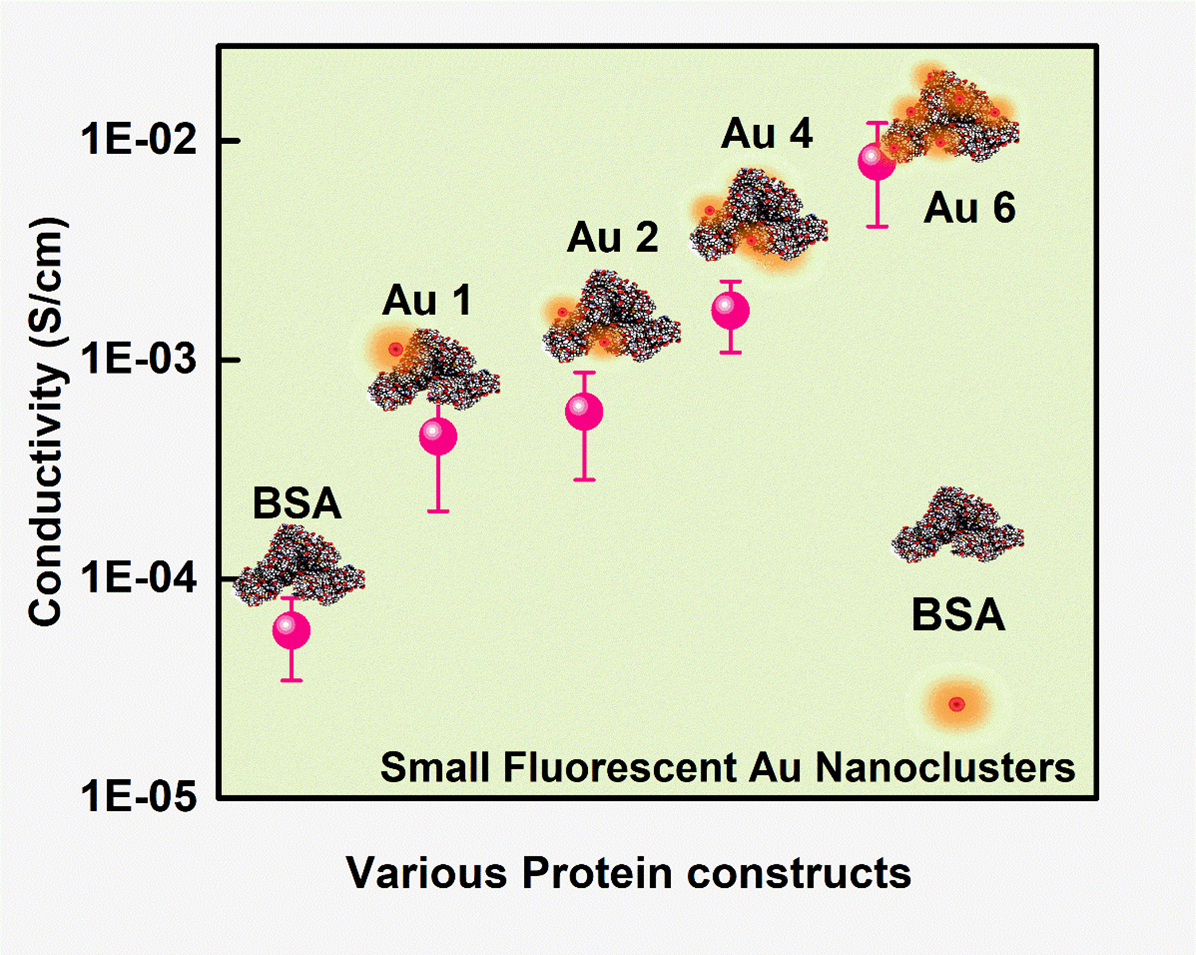
Proteins are the most vital life forms which maintain close coordination with almost living activities through their biological functions. Nevertheless, in most cases, proteins suffer from low charge (electron) transfer efficiency as they are mainly made of insulating organic molecules. The interdisciplinary research publication, of Dr Sabyasachi Mukhopadhyay and Dr Sabyasachi Chakrabortty from the Department of Physics & Department of Chemistry respectively, along with their PhD scholars: Ms Ashwini Nawade, Mr Kumar Babu Busi and Ms Kunchanapalli Ramya, envisions the molecular-level understanding of the charge transport behaviour of various protein-metal nanocluster hybrid.
The article titled ‘“Improved Charge Transport across Bovine Serum Albumin – Au Nanoclusters’ Hybrid Molecular Junction” was featured in the prestigious Q1 journal ACS Omega (IF: 3.512), published by the ‘American Chemical Society’. They successfully incorporated Gold Nanoclusters inside the protein backbone leading to an increase in their conductivity. This will provide new avenues for the rational design of bioelectronic devices with optimized features. The BSA-Au cluster has been a promising model for bioelectronic functionalities. With an increase in their current carrying capacity, they can be used for many more applications, especially as the interface between tissue and organ in biocompatible devices. The research team is also planning to work with various protein dopants to understand their charge transport mechanism. These studies will help in using the protein for various applications mainly in bioimplants or biosensors for drug testing and diagnostics purposes.
Abstract of the Research
Proteins, a highly complex substance, have been the essential element in the living organism where various applications are envisioned due to their biocompatible nature. Apart from protein’s biological functions, contemporary research mainly focuses on their evolving potential associated with nanoscale electronics. Here, we report one type of chemical doping process in model protein molecules (BSA) to modulate its electrical conductivity by incorporating metal (Gold) nanoclusters on the surface or within it. The as-synthesized Au NCs incorporated inside the BSA (Au 1 to Au 6) were optically well characterized with UV-Vis, time-resolved photoluminescence (TRPL), X-ray photon spectroscopy, and high-resolution transmission electron microscopy techniques. The PL quantum yield for Au 1 is 6.8% whereas Au 6 is 0.03%. In addition, the electrical measurements showed ~10-fold enhancement of conductivity in Au 6 where maximum loading of Au NCs was predicted inside the protein matrix. We observed a dynamic behaviour in the electrical conduction of such protein-nanocluster films, which could have real-time applications in preparing biocompatible electronic devices.
- Published in Chemistry-news, Departmental News, News, Physics News, Research News
A unique bridging facets assembly of gold nanorods
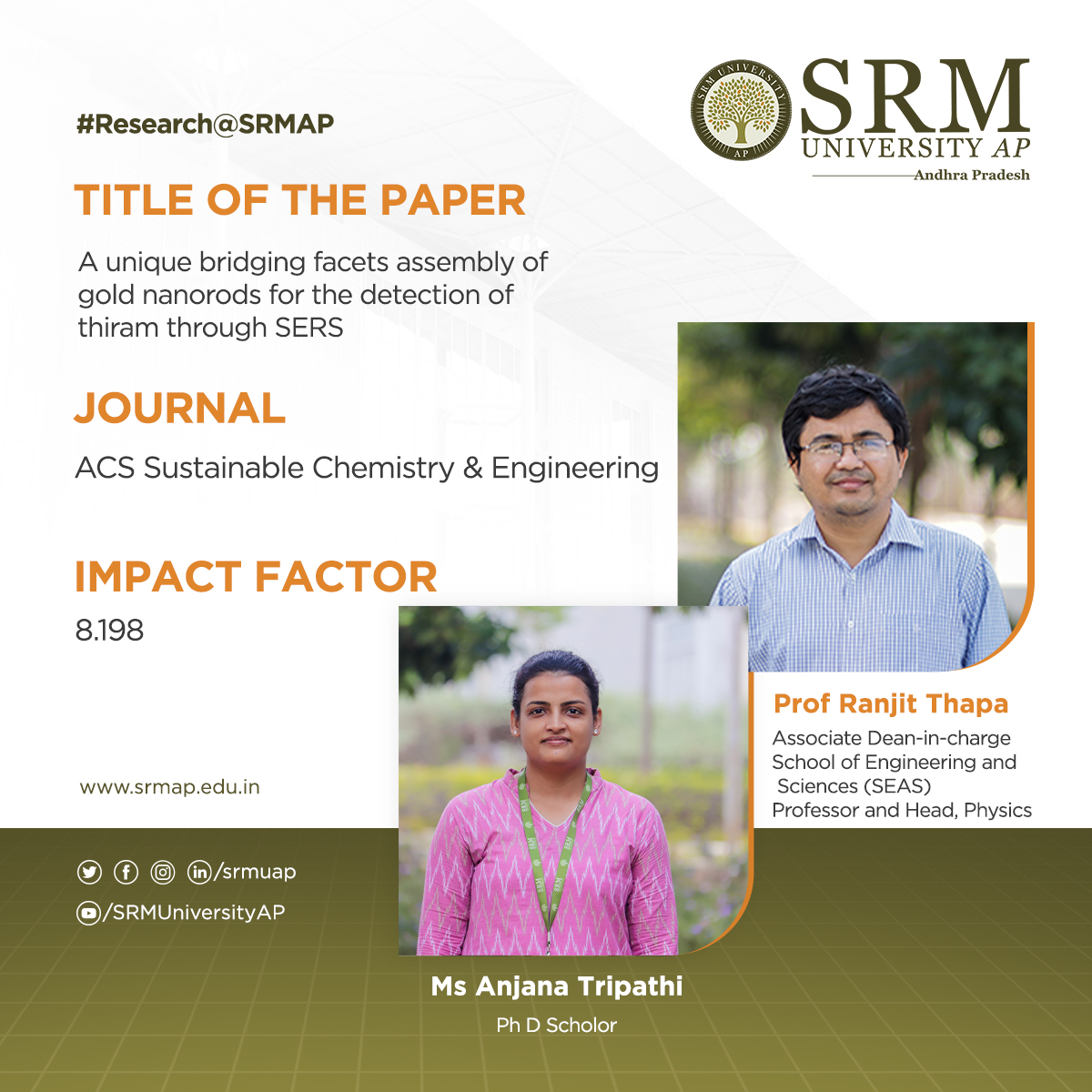 The paper “A unique bridging facets assembly of gold nanorods for the detection of thiram through SERS” has been published by Prof Ranjit Thapa, Professor of Physics and his PhD student, Ms Anjana Tripathi, in ACS Sustainable Chemistry & Engineering having an Impact Factor of 8.198.
The paper “A unique bridging facets assembly of gold nanorods for the detection of thiram through SERS” has been published by Prof Ranjit Thapa, Professor of Physics and his PhD student, Ms Anjana Tripathi, in ACS Sustainable Chemistry & Engineering having an Impact Factor of 8.198.
Abstract
The addition of Au NRs (Gold Nanorods) to TRM (Thiram) of higher and lower concentrations, yields side-by-side assembly (SSA) and bridging facets assembly (BFA), respectively, and exhibited excellent hotspots for the ultra-low detection of TRM. Bridging facets of Au NRs, such as (5 12 0) and (5 0 12) planes are mainly responsible for the BFA. This kind of interaction is observed for the first time and not reported elsewhere. The detailed facets of Au NRs, namely side facets, bridging facets, and pyramid facets, were discussed with the 3D model of Au NRs. The computational studies confirm the SSA and BFA for Au NRs with varying concentrations of TRM are well in agreement with the experimental results.
Research in brief
Au NRs were synthesized successfully using the seed-mediated method and characterized by UV-Vis analysis, SEM, TEM, FT-IR, Raman, and XPS analysis. Synthesized Au NRs were employed for the detection of TRM. Upon adding Au NRs to TRM of higher and lower concentrations yields side by side (SSA) and bridging facet assembly (BFA), validated by TEM analysis. This unique BFA was observed for the first time and not reported before to the best of our knowledge. Elemental mapping confirms the good adsorption of TRM over Au NRs, and FT-IR, Raman, SERS, and XPS analysis confirm the adsorption of TRM on Au NRs through Au-S bond. A uniformity study was performed for the TRM-Au NRs sample using 25 random places and obtained an RSD of ≤ 10% for each peak in SERS. This shows TRM is uniformly adsorbed on Au NRs. LOD and EF were achieved at 10 pM and 2.8 ×106, respectively. Hence, Au NRs are considered an excellent substrate for the detection of TRM. The unique assembly of BFA may play a significant role in the research community to further study the facet-dependent interactions of nanostructures. The computational study was performed to know the reason behind SSA and BFA. The density functional theory (DFT) was carried out using the Vienna Ab-initio Simulation Package (VASP). The Perdew-Burke-Ernzerhof (PBE) functional within Generalized Gradient Approximation (GGA) is adopted to treat the exchange-correlation interactions. These studies confirm the formation of a strong bond between Au and S, as well as the SSA and BFA for higher and lower TRM concentrations with Au NRs. The binding energy of TRM in SSA and BFA is -3.81 eV and 3.19 eV respectively. From the theory, it shows that TRM of lower concentration form BFA and higher concentration of TRM, due to high barrier energy for TRM diffusion, Au NRs form SSA. In this respect, we calculated the activation barrier for thiram migration from edge site (BFA) to in between site (SSA). Results indicate that TRM needs 2.40 eV energy to migrate from the edge site to in between site to form side-by-side assembly. Therefore, for diffusion from edge to in between (SSA) site high-energy barrier is required i.e. higher concentration is required for such configuration. Hence, at low concentration, TRM will form bridge facet assembly and due to high barrier energy for TRM diffusion, the side-by-side assembly is possible only at high concentration.
Practical implementation/social implications
Concerns have grown in recent years about the widespread use of the pesticide thiram (TRM), which has been linked to negative effects on local ecosystems. This highlights the critical need for quick and accurate point-of-need pesticide analysis tools for real-time applications. The detection of TRM using gold nanorods (Au NRs) with a limit of detection (LOD) of 10-11 M (10 pM) and an enhancement factor (EF) of 2.8 × 106 along with 6.2% of signal homogeneity (with respect to peak at 1378 cm-1) achieved through surface-enhanced Raman scattering (SERS). The interaction of Au NRs with TRM is sensitive, and ultra-low detection of hazardous TRM through SERS makes an ideal technique for environmental protection, real-time applications, and analysis of one-of-a-kind materials.
Collaborations
Bhavya M. B, Akshaya K. Samal
Institute: Centre for Nano and Material Sciences, Jain University, Jain Global Campus
Ramanagara, Bangalore 562112, India
- Published in Departmental News, News, Physics News, Research News

